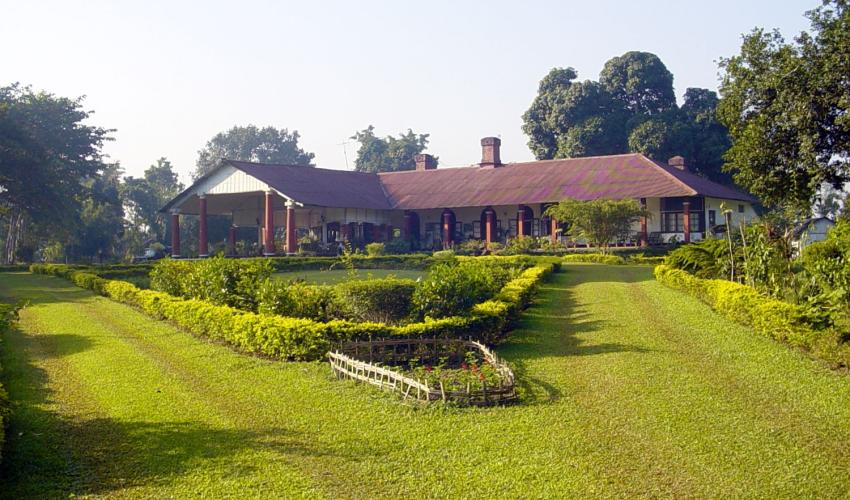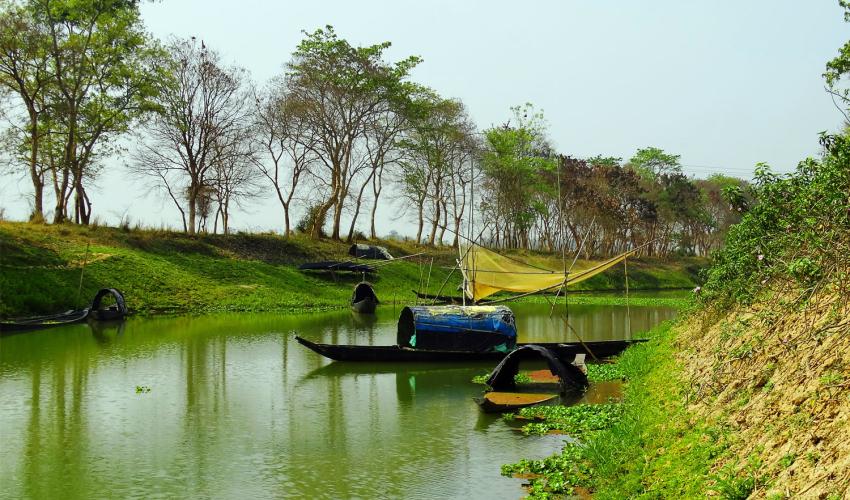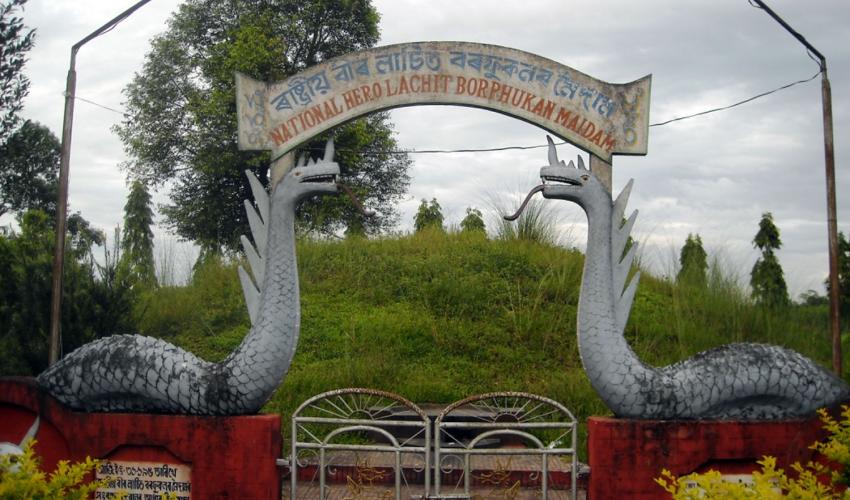One of the largest towns of Assam, Jorhat acts as a portal to upper Assam and to the state of Nagaland. It draws its name from two ‘haats’ or ‘bazaars’ namely Macharhat and Chowkihat, on either bank of river Bhogdoi, a tributary of the mighty Brahmaputra. It was the last capital of the Ahom Kingdom and a major attraction for tourists as many historical monuments of Assamese culture are found here. To the north of the Jorhat district, the Brahmaputra river forms the largest river island of the world, Majuli. In present times, often referred to as Assam’s tea capital, Jorhat is home to around 300 tea estates. Some of the tea estates have colonial bungalows which have been renovated for exclusive, niche tourists. Jorhat has various outlets of traditional Assamese jewellery and craft fashioned from tea bushes and driftwood.
Jorhat town boasts of its 11 research institutes, including the oldest and largest institution in the world, dedicated to tea research, Tocklai Experimental Station which was established in 1911. Rainforest Research Institute and Regional Sericulture Research Centre are some other research institutes. In the heart of the Jorhat town is BuriGosai Than, a Shakti sanctum. Situated 3kms north of the town at Baligaon is Gorokhia Than, a Shiva temple constructed in 1714. The monumental Negheriting Shiva Dol, stands on a hillock, overlooking the Negheriting Tea Estate. The DakhinpatSatra, a Vaishavite Faith monastery is situated 14kms east of Jorhat, amidst idyllic rural setting. Several medieval community ponds like Mithapukhuri, Kunworipukhuri and Bangalpukhuri add to the appeal of Jorhat.
Some of the noted tourist destinations are listed below:
JORHAT GYMKHANA CLUB
Recognised as the oldest golf course in Asia and third oldest in the world, Jorhat Gymkhana Club was established by the British in 1876. The club has been a ground for horse races ever since its inauguration. The Governor’s Cup is the major trophy rewarded every year. It has a lush green 9-hole golf course. Striving for a position in the ‘World Heritage List’ as the oldest golf course in Asia and third oldest in the world, the Club provides facilities in lawn tennis grass courts, swimming pool, billiards, polo, gentleman’s bar and cinema theatre.
RAJA MAIDAM
The Raja Maidam (vault) which is located on the south bank of river Tocklai on the northern side of Jorhat town was established to preserve the ashes of the last Ahom King PurandarSingha who expired on 1st October 1848.
DHEKIAKHOWA BORNAMGHAR
The DhekiakhowaBornamghar, a significant site for tourists and pilgrims, is a beautiful and vibrant centre depicting Vaishnavism (worship of Lord Vishnu) and the culture of Assam. Established by Saint-reformer, Sri SriMadhavdeva, who was a disciple of SrimantaShankardeva, it is one of the most renowned religious destinations in the Dhekiakhowa village of Jorhat in the state of Assam. The name ‘Dhekiakhowa’ originated from two words that is ‘dhekia which means the fern and ‘khowa’ which means to eat in Assamese. Huge number of devotees visit the Namghar every day, especially during the month of Bhadra (from mid-August to mid-September) devotees take active part in the NaamProxango (hymns sung together by the devotees in the prayer hall). A large number of idols of Hindu deities can be seen inside the Namghar.
SHYAMGAON
Situated about 25kms from Jorhat, Shyamgaon is recognised as one of the ancient Buddhist settlement in Assam. Balijan Buddhist Vihara, surrounded by lush greenery, presents six Buddhist villages in the vicinity. It has a white statue of Shakyamuni Buddha along with a gilded manuscript and silken gown, presented in 1826 by a Burmese King to Buddhists who migrated here from Myanmar’s Shan province.
GIBBON WILDLEFE SANCTUARY
Named after the only ape (Hoolock Gibbon) found in India, Gibbon Wildlife Sanctuary is covered with semi-evergreen forests and lush evergreen patches, surrounded by tea gardens and human settlements. The forest has a rich biodiversity. Since its formulation, the Gibbon Wildlife Sanctuary has been working significantly on the research and conservation of the primate community of the animal kingdom. At present, the Sanctuary is habitat to seven species of primates namely – the Western Hoolock Gibbon, Capped Langur, Bengal Slow Loris, Stump Tailed Macaque, Northern Pig Tailed Macaque, Rhesus Macaque and the Assamese Macaque. It is also a home to different species of birds like the Red Jungle Fowl, Kalij Pheasant, Common Teal, Common Pochard, Great Hornbill, Red Breasted Parakeet, Drongo Cuckoo, Spotted Dove etc. Because of its rich biodiversity, this Sanctuary attracts tourists from all over the world. Bungalows have been built by the forest department for accommodation purposes.
LACHIT BORPHUKAN’S MAIDAM
Situated at Gohaingaon of Meleng-Hulungapar, 8kms from Gibbon Wildlife Sanctuary, this is the Maidam of the greatest Ahom General ever, LachitBorphukan. He conquered the mighty Mughals at Saraighat in 1672. He passed away, a year later and his remains were preserved in this Maidam by SwargadeoUdayadityaSingha.
MULAI FOREST
MulaiKathoni or Mulai Forest is a 550acre man-made forest which is situated at a village named Kokilamukh in Jorhat. Known as the ‘forest man of India’, a recipient of the Padmashree award, JadavMulaiPayeng, with his remarkable work, upgraded a chapori of the river Brahmaputra to this forest.
MAJULI
Situated on the banks of the river Brahmaputra, Majuli is the largest fresh water river island in the world. The island with its wide blue sky, sparkling waters of the mighty Brahmaputra and the beautiful landscapes induces a mesmerizing picture. Known for its rare bio-diversity, it is home to thousands of rare migratory birds like the Pelican, Siberian Crane, Greater Adjutant etc. Often referred to as the ‘Cultural Capital of Assam’, Majuli has a rich heritage and is the nucleus of the Vaishnav culture propagated by SrimantaShankardev, a renowned social reformer of the 16th century, who started the Neo-Vashnavite movement in Assam. He constituted a number of monasteries which are popularly known as ‘Satras’. The Satras consist of a spacious prayer hall facing a simple shrine enclosed by dormitories and bathing tanks for monks. Apart from the Satras and the natural beauty, Majuli also boasts of its unique handmade products like masks and pottery and weaving of intricate fabrics.
Known for its cultural celebration, Majuli attracts a lot of tourists from across the globe during its festivals. The famous ‘Raas Purnima’, which is celebrated in the Hindu month of Kartik exhibits a dance performance revolving around Lord Sri Krishna’s life and the ‘Majuli festival’ which hosts special events where several cultural troupes from all over Assam come and perform, sees a lot of footfalls. Some tourists also come for the ‘PaalNaam’ which happens at the end of Autumn and the Bathow Puja where Lord Shiva is worshipped. Out of the 22 Satras in this island, KamalabariSatra, AuniatiSatra, DakhinpatSatra, GaramurhSatra, BengenatiSatra and ShamaguriSatra are worth mentioning.
MOU CHAPORI
Located at Neematighat, MouChapori is a small river island on the Brahmaputra. It is an ideal destination for family holidays. Attractive cottages are available at reasonable prices.
JORHAT DISTRICT MUSEUM
Situated in the P.G. Training College complex. this mini museum exhibits metal icons and stone sculptures, sins of Sashi bark, man-made paper and weapons of Ahom dynasty.
HOW TO REACH JORHAT
Jorhat has its own airport, Rowriah Airport which is situated 7kms from the heart of the city. Jorhat Town Railway Station and Mariani Junction Railway Station are the major stations of Jorhat. Jorhat is well connected by road with all major cities of North-East India. Buses and taxis are available at regular intervals. NH-37 connects Jorhat with all the major cities of Assam.
Jorhat
Assam



